check engine CHRYSLER 200 CONVERTIBLE 2012 1.G Owner's Manual
[x] Cancel search | Manufacturer: CHRYSLER, Model Year: 2012, Model line: 200 CONVERTIBLE, Model: CHRYSLER 200 CONVERTIBLE 2012 1.GPages: 517, PDF Size: 3.17 MB
Page 441 of 517
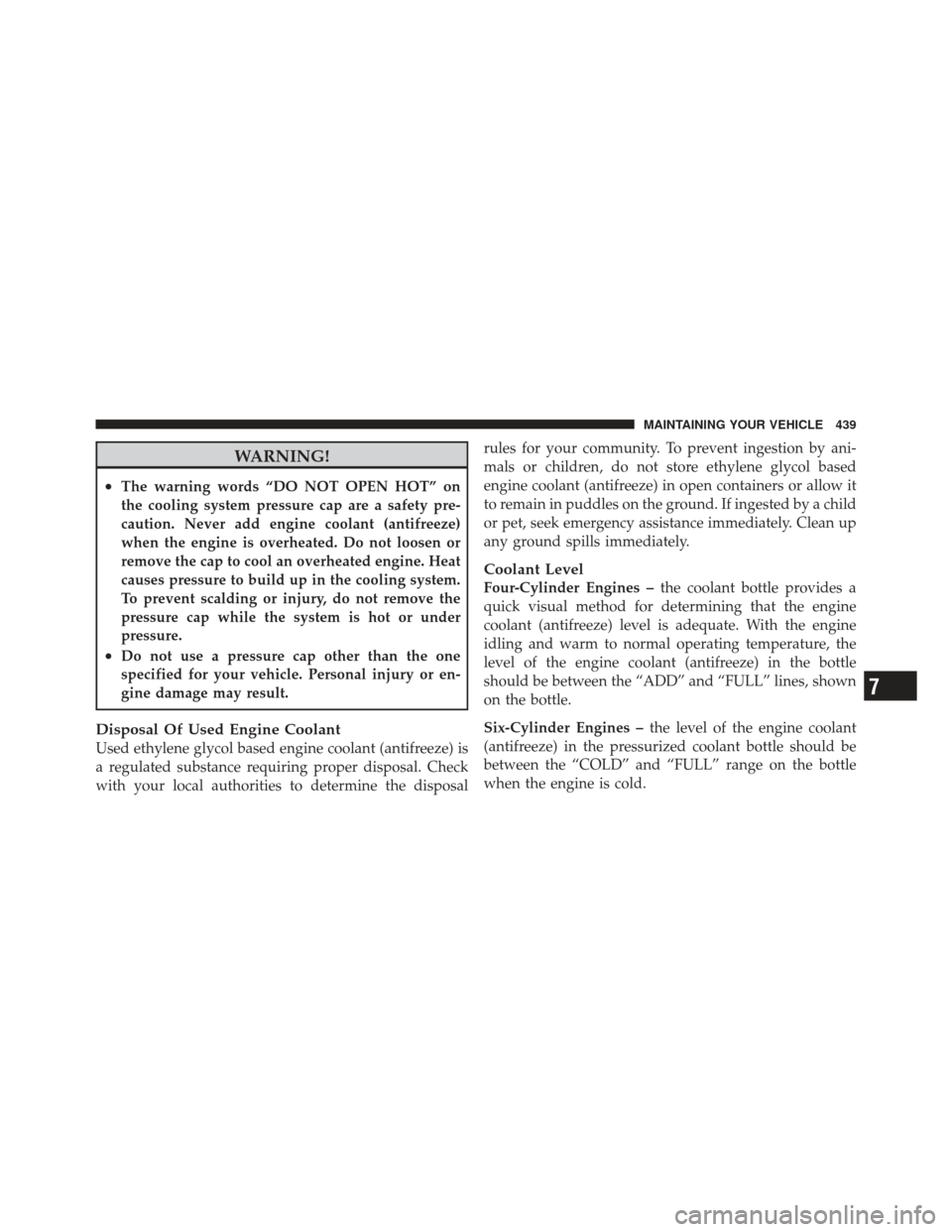
WARNING!
•The warning words “DO NOT OPEN HOT” on
the cooling system pressure cap are a safety pre-
caution. Never add engine coolant (antifreeze)
when the engine is overheated. Do not loosen or
remove the cap to cool an overheated engine. Heat
causes pressure to build up in the cooling system.
To prevent scalding or injury, do not remove the
pressure cap while the system is hot or under
pressure.
•Do not use a pressure cap other than the one
specified for your vehicle. Personal injury or en-
gine damage may result.
Disposal Of Used Engine Coolant
Used ethylene glycol based engine coolant (antifreeze) is
a regulated substance requiring proper disposal. Check
with your local authorities to determine the disposalrules for your community. To prevent ingestion by ani-
mals or children, do not store ethylene glycol based
engine coolant (antifreeze) in open containers or allow it
to remain in puddles on the ground. If ingested by a child
or pet, seek emergency assistance immediately. Clean up
any ground spills immediately.
Coolant Level
Four-Cylinder Engines –
the coolant bottle provides a
quick visual method for determining that the engine
coolant (antifreeze) level is adequate. With the engine
idling and warm to normal operating temperature, the
level of the engine coolant (antifreeze) in the bottle
should be between the “ADD” and “FULL” lines, shown
on the bottle.
Six-Cylinder Engines – the level of the engine coolant
(antifreeze) in the pressurized coolant bottle should be
between the “COLD” and “FULL” range on the bottle
when the engine is cold.
7
MAINTAINING YOUR VEHICLE 439
Page 442 of 517
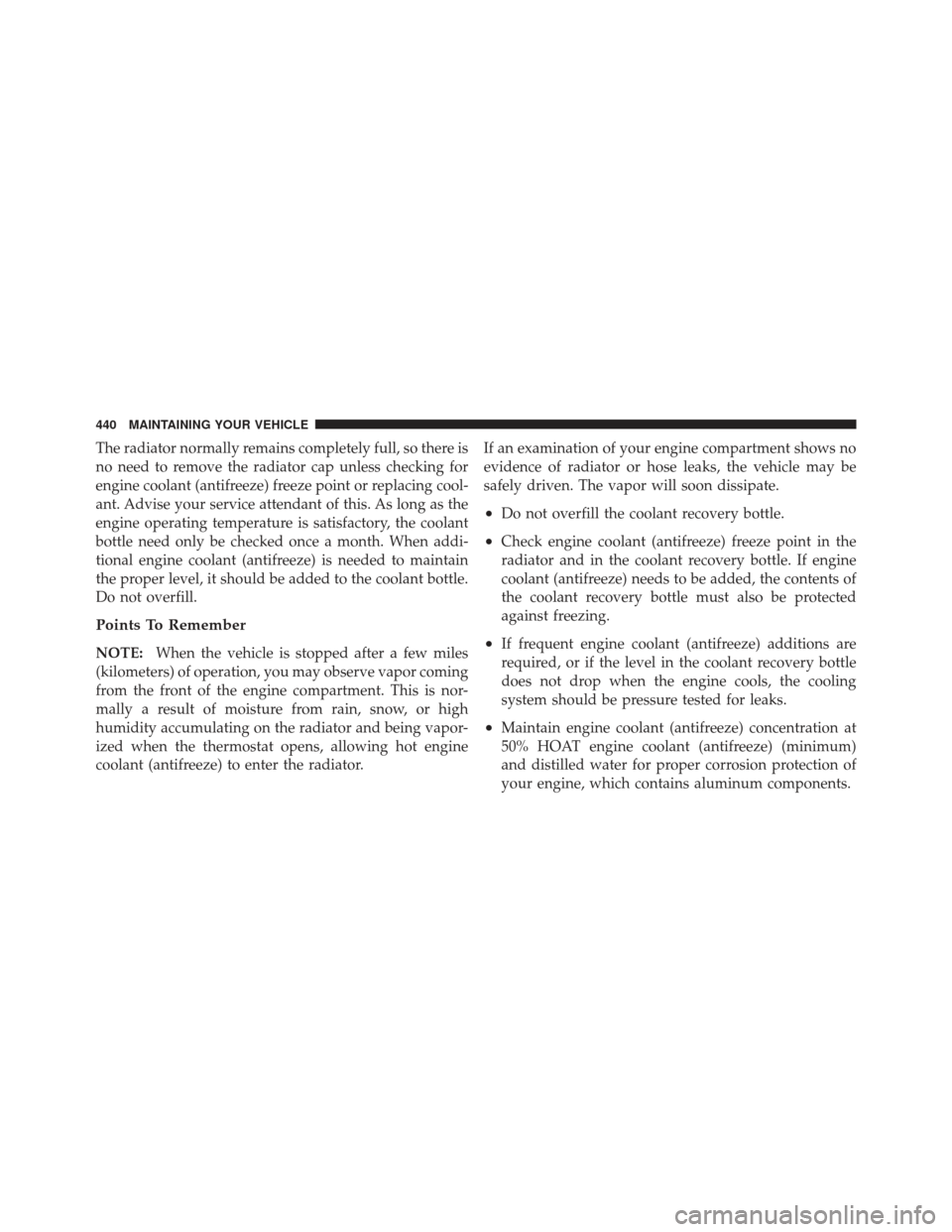
The radiator normally remains completely full, so there is
no need to remove the radiator cap unless checking for
engine coolant (antifreeze) freeze point or replacing cool-
ant. Advise your service attendant of this. As long as the
engine operating temperature is satisfactory, the coolant
bottle need only be checked once a month. When addi-
tional engine coolant (antifreeze) is needed to maintain
the proper level, it should be added to the coolant bottle.
Do not overfill.
Points To Remember
NOTE:When the vehicle is stopped after a few miles
(kilometers) of operation, you may observe vapor coming
from the front of the engine compartment. This is nor-
mally a result of moisture from rain, snow, or high
humidity accumulating on the radiator and being vapor-
ized when the thermostat opens, allowing hot engine
coolant (antifreeze) to enter the radiator. If an examination of your engine compartment shows no
evidence of radiator or hose leaks, the vehicle may be
safely driven. The vapor will soon dissipate.
•Do not overfill the coolant recovery bottle.
•Check engine coolant (antifreeze) freeze point in the
radiator and in the coolant recovery bottle. If engine
coolant (antifreeze) needs to be added, the contents of
the coolant recovery bottle must also be protected
against freezing.
•If frequent engine coolant (antifreeze) additions are
required, or if the level in the coolant recovery bottle
does not drop when the engine cools, the cooling
system should be pressure tested for leaks.
•Maintain engine coolant (antifreeze) concentration at
50% HOAT engine coolant (antifreeze) (minimum)
and distilled water for proper corrosion protection of
your engine, which contains aluminum components.
440 MAINTAINING YOUR VEHICLE
Page 445 of 517
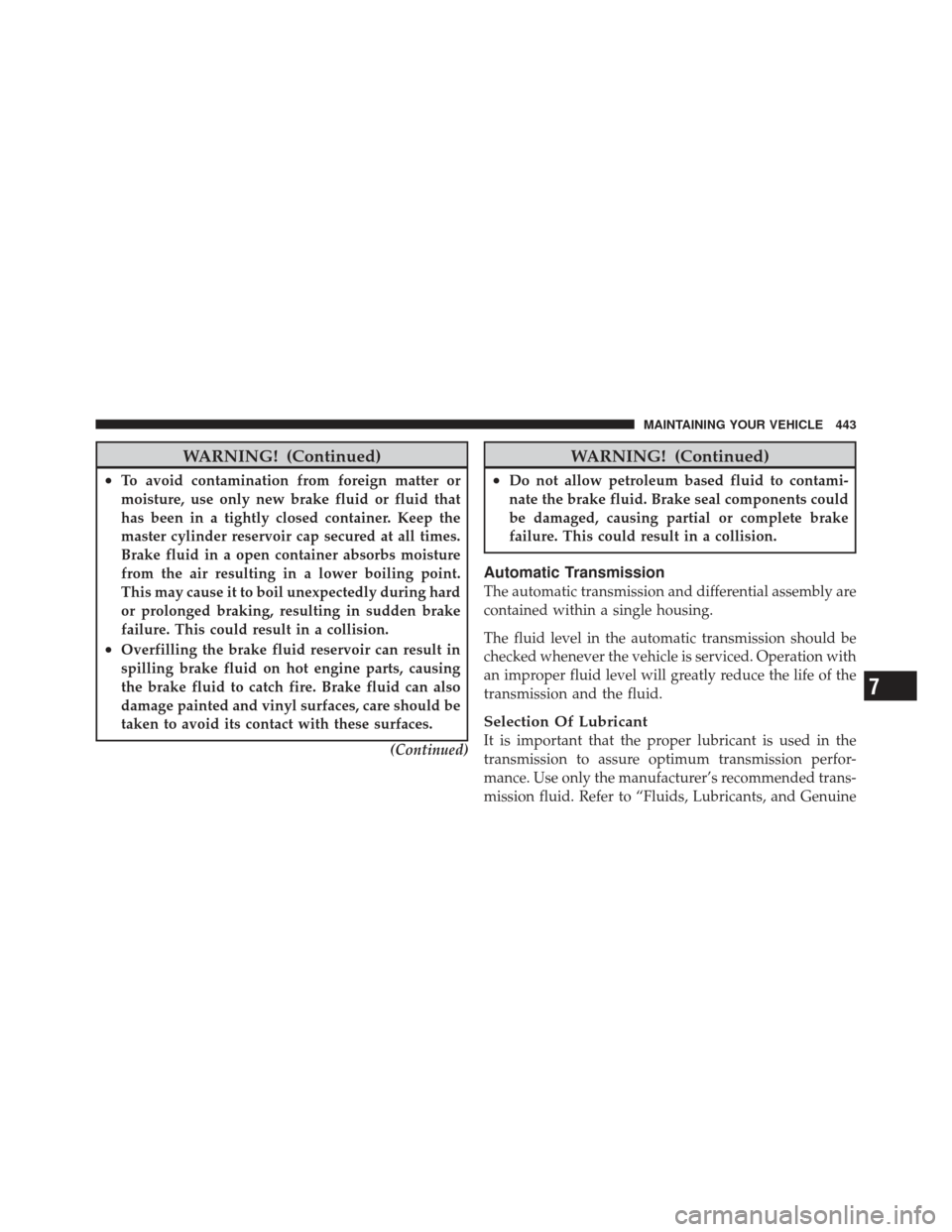
WARNING! (Continued)
•To avoid contamination from foreign matter or
moisture, use only new brake fluid or fluid that
has been in a tightly closed container. Keep the
master cylinder reservoir cap secured at all times.
Brake fluid in a open container absorbs moisture
from the air resulting in a lower boiling point.
This may cause it to boil unexpectedly during hard
or prolonged braking, resulting in sudden brake
failure. This could result in a collision.
•Overfilling the brake fluid reservoir can result in
spilling brake fluid on hot engine parts, causing
the brake fluid to catch fire. Brake fluid can also
damage painted and vinyl surfaces, care should be
taken to avoid its contact with these surfaces.(Continued)
WARNING! (Continued)
•Do not allow petroleum based fluid to contami-
nate the brake fluid. Brake seal components could
be damaged, causing partial or complete brake
failure. This could result in a collision.
Automatic Transmission
The automatic transmission and differential assembly are
contained within a single housing.
The fluid level in the automatic transmission should be
checked whenever the vehicle is serviced. Operation with
an improper fluid level will greatly reduce the life of the
transmission and the fluid.
Selection Of Lubricant
It is important that the proper lubricant is used in the
transmission to assure optimum transmission perfor-
mance. Use only the manufacturer’s recommended trans-
mission fluid. Refer to “Fluids, Lubricants, and Genuine
7
MAINTAINING YOUR VEHICLE 443
Page 446 of 517
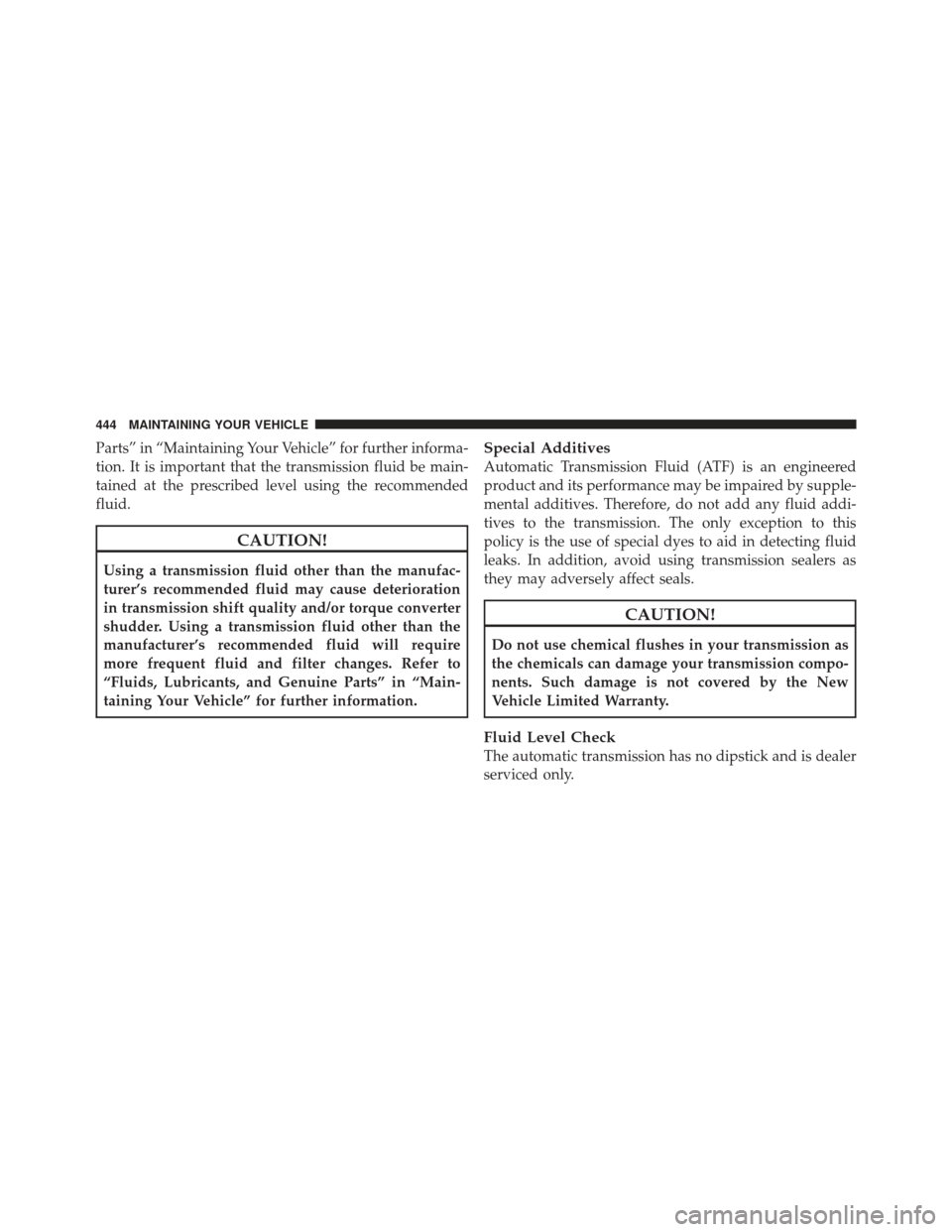
Parts” in “Maintaining Your Vehicle” for further informa-
tion. It is important that the transmission fluid be main-
tained at the prescribed level using the recommended
fluid.
CAUTION!
Using a transmission fluid other than the manufac-
turer’s recommended fluid may cause deterioration
in transmission shift quality and/or torque converter
shudder. Using a transmission fluid other than the
manufacturer’s recommended fluid will require
more frequent fluid and filter changes. Refer to
“Fluids, Lubricants, and Genuine Parts” in “Main-
taining Your Vehicle” for further information.
Special Additives
Automatic Transmission Fluid (ATF) is an engineered
product and its performance may be impaired by supple-
mental additives. Therefore, do not add any fluid addi-
tives to the transmission. The only exception to this
policy is the use of special dyes to aid in detecting fluid
leaks. In addition, avoid using transmission sealers as
they may adversely affect seals.
CAUTION!
Do not use chemical flushes in your transmission as
the chemicals can damage your transmission compo-
nents. Such damage is not covered by the New
Vehicle Limited Warranty.
Fluid Level Check
The automatic transmission has no dipstick and is dealer
serviced only.
444 MAINTAINING YOUR VEHICLE
Page 473 of 517
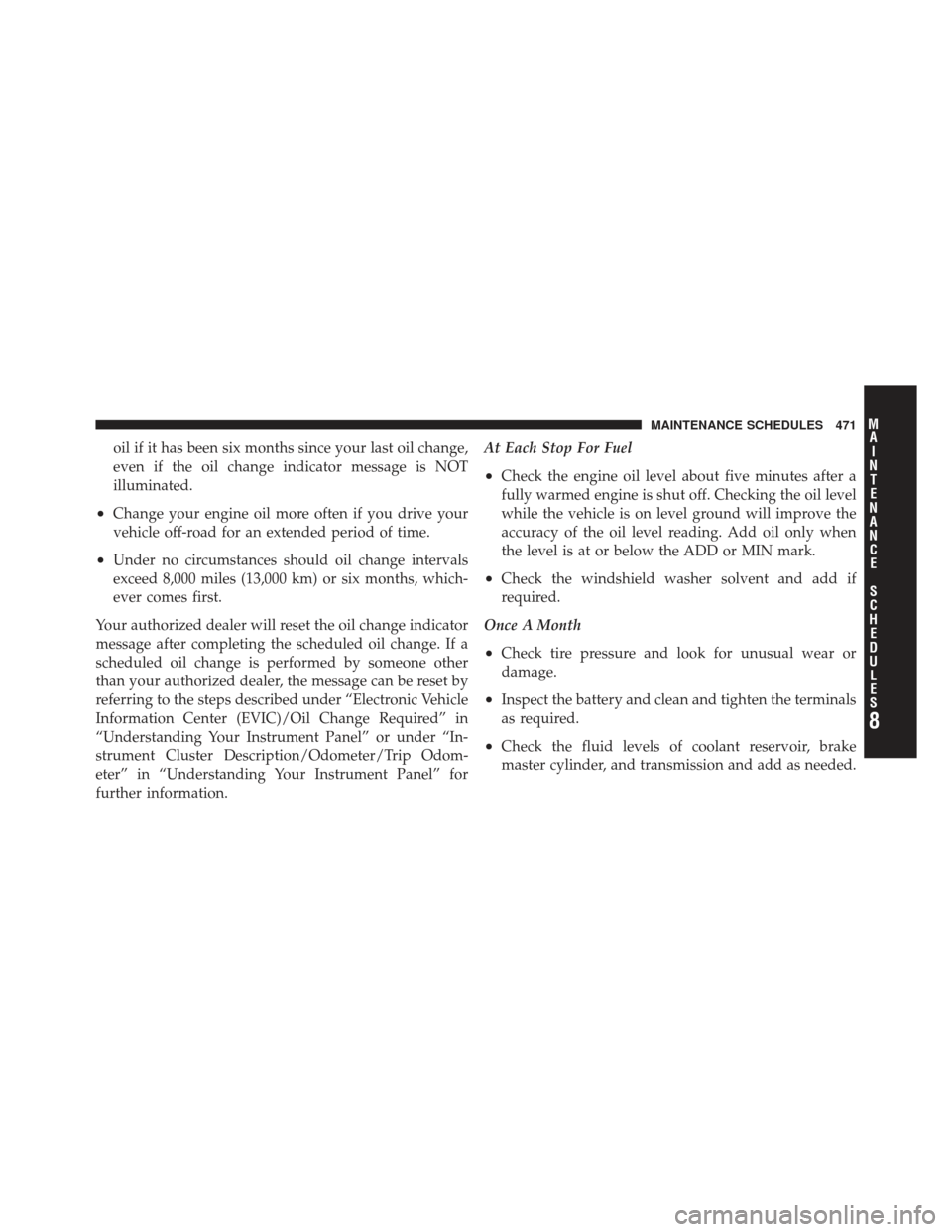
oil if it has been six months since your last oil change,
even if the oil change indicator message is NOT
illuminated.
•Change your engine oil more often if you drive your
vehicle off-road for an extended period of time.
•Under no circumstances should oil change intervals
exceed 8,000 miles (13,000 km) or six months, which-
ever comes first.
Your authorized dealer will reset the oil change indicator
message after completing the scheduled oil change. If a
scheduled oil change is performed by someone other
than your authorized dealer, the message can be reset by
referring to the steps described under “Electronic Vehicle
Information Center (EVIC)/Oil Change Required” in
“Understanding Your Instrument Panel” or under “In-
strument Cluster Description/Odometer/Trip Odom-
eter” in “Understanding Your Instrument Panel” for
further information. At Each Stop For Fuel
•Check the engine oil level about five minutes after a
fully warmed engine is shut off. Checking the oil level
while the vehicle is on level ground will improve the
accuracy of the oil level reading. Add oil only when
the level is at or below the ADD or MIN mark.
•Check the windshield washer solvent and add if
required.
Once A Month
•Check tire pressure and look for unusual wear or
damage.
•Inspect the battery and clean and tighten the terminals
as required.
•Check the fluid levels of coolant reservoir, brake
master cylinder, and transmission and add as needed.
8
M A I
N T
E
N A
N CE
S
C
H E
D
U L
E
SMAINTENANCE SCHEDULES 471
Page 474 of 517
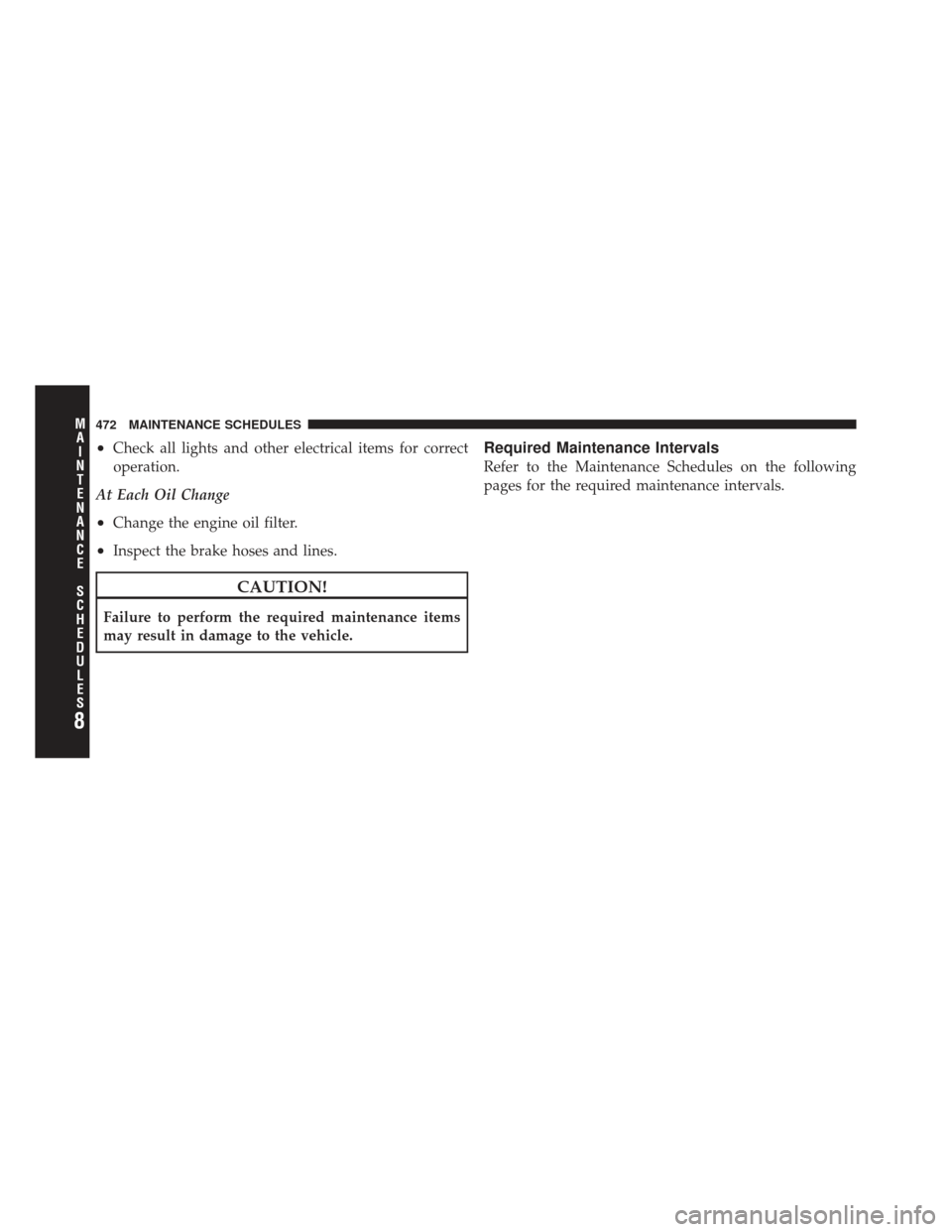
•Check all lights and other electrical items for correct
operation.
At Each Oil Change
•Change the engine oil filter.
•Inspect the brake hoses and lines.
CAUTION!
Failure to perform the required maintenance items
may result in damage to the vehicle.
Required Maintenance Intervals
Refer to the Maintenance Schedules on the following
pages for the required maintenance intervals.
8
M A I
N T
E
N A
N CE
S
C
H E
D
U L
E
S472 MAINTENANCE SCHEDULES
Page 498 of 517
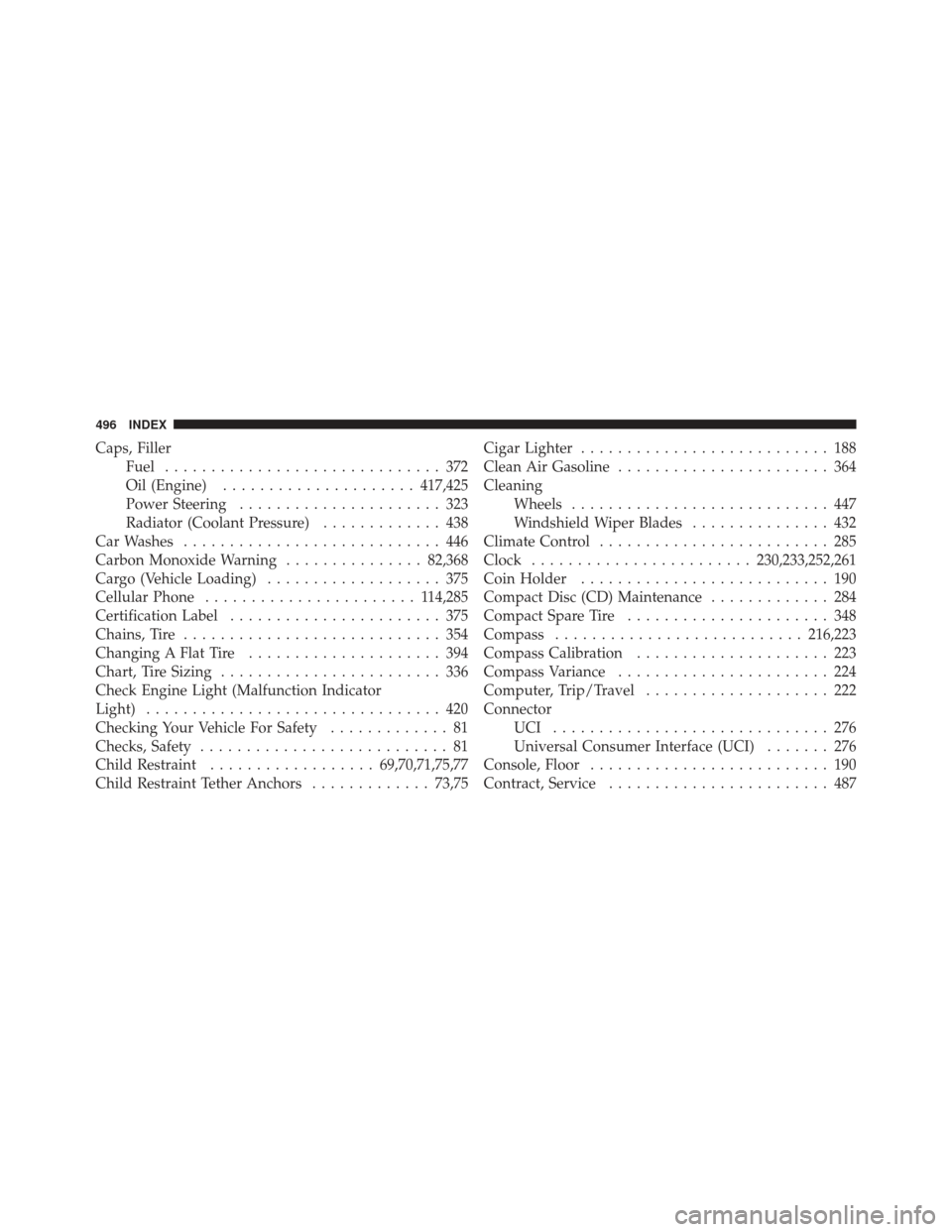
Caps, FillerFuel .............................. 372
Oil (Engine) ..................... 417,425
Power Steering ...................... 323
Radiator (Coolant Pressure) ............. 438
Car Washes ............................ 446
Carbon Monoxide Warning ...............82,368
Cargo (Vehicle Loading) ................... 375
Cellular Phone ....................... 1 14,285
Certification Label ....................... 375
Chains, Tire ............................ 354
Changing A Flat Tire ..................... 394
Chart, Tire Sizing ........................ 336
Check Engine Light (Malfunction Indicator
Light) ................................ 420
Checking Your Vehicle For Safety ............. 81
Checks, Safety ........................... 81
Child Restraint .................. 69,70,71,75,77
Child Restraint Tether Anchors .............73,75Cigar Lighter
........................... 188
Clean Air Gasoline ....................... 364
Cleaning Wheels ............................ 447
Windshield Wiper Blades ............... 432
Climate Control ......................... 285
Clock ........................ 230,233,252,261
Coin Holder ........................... 190
Compact Disc (CD) Maintenance ............. 284
Compact Spare Tire ...................... 348
Compass ........................... 216,223
Compass Calibration ..................... 223
Compass Variance ....................... 224
Computer, Trip/Travel .................... 222
Connector UCI .............................. 276
Universal Consumer Interface (UCI) ....... 276
Console, Floor .......................... 190
Contract, Service ........................ 487
496 INDEX
Page 500 of 517
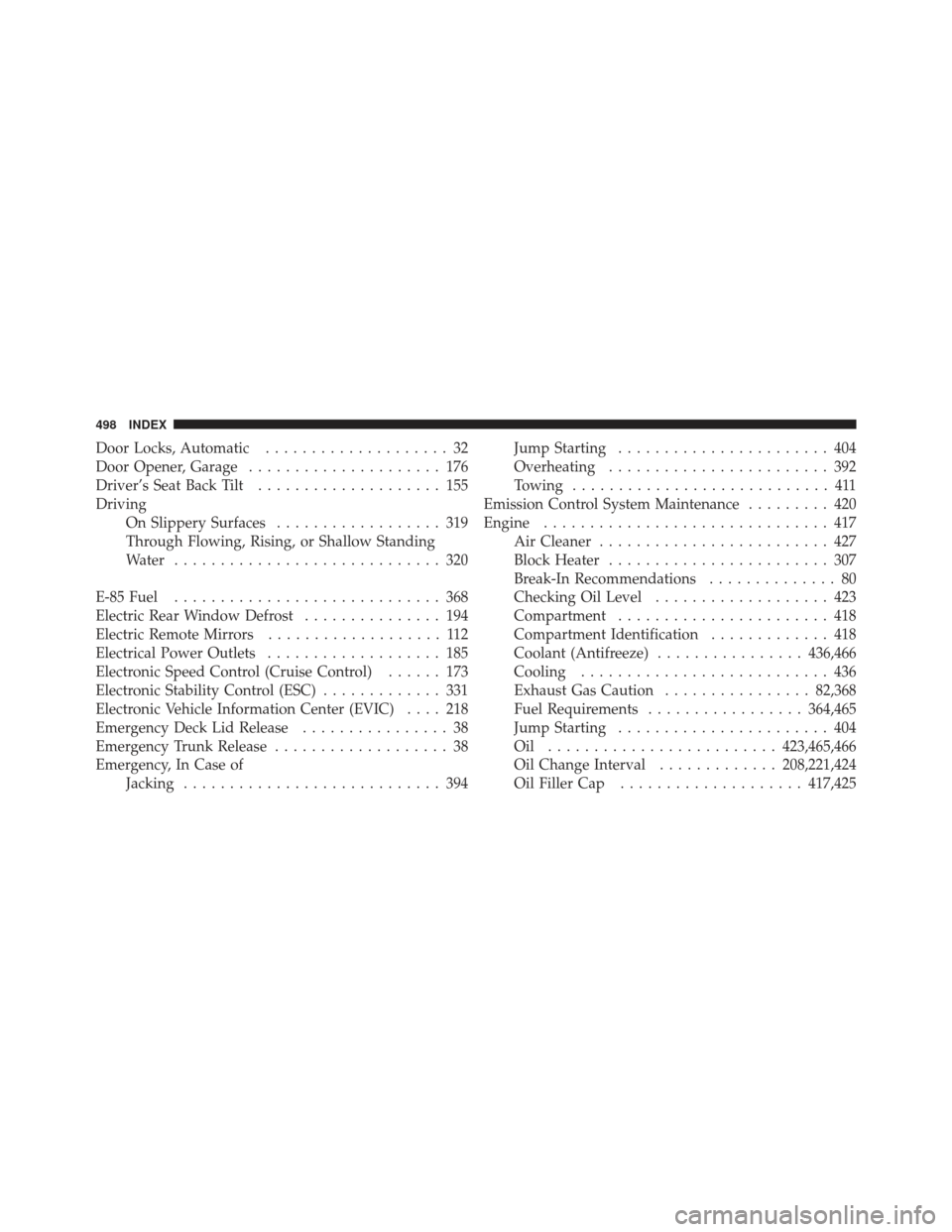
Door Locks, Automatic.................... 32
Door Opener, Garage ..................... 176
Driver’s Seat Back Tilt .................... 155
Driving On Slippery Surfaces .................. 319
Through Flowing, Rising, or Shallow Standing
Water ............................. 320
E-85 Fuel ............................. 368
Electric Rear Window Defrost ............... 194
Electric Remote Mirrors ................... 112
Electrical Power Outlets ................... 185
Electronic Speed Control (Cruise Control) ...... 173
Electronic Stability Control (ESC) ............. 331
Electronic Vehicle Information Center (EVIC) .... 218
Emergency Deck Lid Release ................ 38
Emergency Trunk Release ................... 38
Emergency, In Case of Jacking ............................ 394 Jump Starting
....................... 404
Overheating ........................ 392
Towing ............................ 411
Emission Control System Maintenance ......... 420
Engine ............................... 417
Air Cleaner ......................... 427
Block Heater ........................ 307
Break-In Recommendations .............. 80
Checking Oil Level ................... 423
Compartment ....................... 418
Compartment Identification ............. 418
Coolant (Antifreeze) ................ 436,466
Cooling ........................... 436
Exhaust Gas Caution ................82,368
Fuel Requirements ................. 364,465
Jump Starting ....................... 404
Oil ......................... 423,465,466
Oil Change Interval .............208,221,424
Oil Filler Cap .................... 417,425
498 INDEX
Page 502 of 517

Fluid Capacities......................... 465
Fluid Leaks ............................. 85
Fluid Level Checks Automatic Transmission ................ 444
Brake .......................... 441,467
Cooling System ...................... 436
Engine Oil ......................... 423
Power Steering ................... 323,467
Fluids ................................ 466
Fluids, Lubricants and Genuine Parts .......... 466
Fog Light Service ........................ 462
Fog Lights .................... 161,164,211,462
Freeing A Stuck Vehicle ................... 408
Fuel ................................. 364
Adding ........................... 372
Additives .......................... 366
Clean Air .......................... 364
Ethanol ........................... 365
Filler Cap (Gas Cap) ...............202,372Filler Door (Gas Cap)
.................. 202
Gasoline ........................... 364
Gauge ............................ 202
Light ............................. 203
Materials Added ..................... 366
Methanol .......................... 365
Octane Rating .................... 364,466
Requirements .................... 364,465
Tank Capacity ....................... 465
Fuel System Caution ..................... 373
Fuel, Flexible ........................... 368
Fueling ............................... 372
Fuses ................................ 454
Garage Door Opener (HomeLink®) ........... 176
Gas Cap (Fuel Filler Cap) ............372,374,419
Gasoline, Clean Air ...................... 364
Gasoline, Reformulated ................... 364
500 INDEX
Page 506 of 517

Lights On Reminder.................. 162
Low Fuel .......................... 203
Malfunction Indicator (Check Engine) ...... 214
Map Reading ....................... 167
Oil Pressure ........................ 204
Park ........................... 161,162
Passing ............................ 166
Seat Belt Reminder ................... 203
Security Alarm (Theft Alarm) ............. 19
Theft Alarm (Security Alarm) ............ 211
Tire Pressure Monitoring (TPMS) .......212,355
Traction Control ..................... 333
Turn Signal ............ 85,161,166,210,462,463
Voltage ............................ 203
Warning (Instrument Cluster Description) . . . 202
Loading Vehicle ...................... 375,376
Capacities .......................... 376
Tires .............................. 340
Locks ................................. 30 Auto Unlock
......................... 32
Automatic Door ...................... 32
Door .............................. 30
Power Door ......................... 32
Low Tire Pressure System .................. 355
Lower Anchors and Tether for CHildren
(LATCH) ............................ 73,75
Lubrication, Body ....................... 431
Lumbar Support ........................ 154
Maintenance Free Battery .................. 427
Maintenance Procedures ................... 422
Maintenance Schedule .................... 470
Maintenance, General ..................... 422
Malfunction Indicator Light (Check Engine) . . 214,420
Manual, Service ......................... 489
Map/Reading Lights ..................... 167
Master Cylinder (Brakes) .................. 441
Memory Feature (Memory Seat) ............. 155
504 INDEX